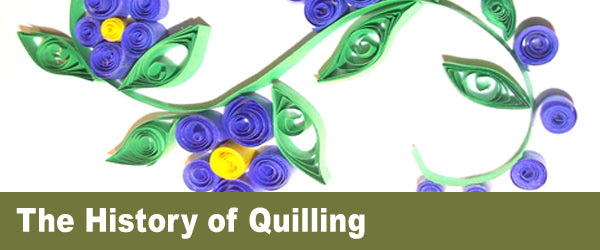
Posted by The Home School in the Woods Team on
What is something Jane Austen, the Brontë sisters, and Joseph Bramah had in common? The answer may shock you – it's quilling!
Paper quilling is an art form that involves the manipulation of paper to create breathtaking designs. Even though this craft is centuries old, it continues to be an art form loved by all generations.
Continuing on with our "Crafting Through the Ages" series, we'll discuss the history behind quilling paper and why this hands-on craft is worth including in your child's history lessons!
You can find the art of quilling in our Colonial Life Time Traveler or as a separate à la carte project.
What Is Quilling?
Quilling, sometimes called paper rolling or paper filigree, is a decorative art form that uses colored paper strips. These strips are coiled, curled, and twisted to create decorative designs on greeting cards, boxes, pictures, and more. Glue is used to secure the pieces in place.
Although this craft has existed for thousands of years, it has recently gained popularity by crafters worldwide. It can be seen as jewelry, florals, three-dimensional miniatures, and other abstract art pieces.
The History of Quilling
Paper quilling can be traced back to the 15th century. However, some historians believe it originated in Ancient Egypt! Although the exact origins are somewhat of a mystery, one thing we know to be true is that quilling was widely practiced in 18th-century France, Italy, and England.
During the Renaissance period, nuns and monks took up quilling as a way to imitate the ironwork. To save money, poor churches perfected the art of quilling to decorate various objects like the edging of holy books.
The designs were so intricate and well done that it was difficult to tell the difference between them and real gold or silver pieces carved by blacksmiths! From that moment forward, quilling became a popular art form practiced throughout Europe.
Quilling, as well as embroidery, became a necessary skill to teach young women in boarding schools, as it was considered to be a leisure activity that wasn't too taxing.
Quilling quickly spread to America, its popularity being during the Colonial period. Today, you can find spectacular quilling artwork at craft shows and museums.
Why Is It Important to Teach Children the Art of Quilling?
Quilling, like many other crafts, gives children an opportunity to express their creativity and learn a new skill that could come in handy years down the road! Many crafters enjoy quilling flowers and placing them on scrapbooks, picture frames, storage baskets, decorative boxes, coasters, cards, and more.
This art form is a fun, inexpensive way for children to make gifts for friends and family around the holidays and as birthday gifts, but it's also an important piece of history worth knowing about.
Coming from experience, my children loved learning how to quill – especially the boys! In fact, my son made a three-dimensional model of Sauron's eye from the Lord of the Rings and still keeps it on his bookshelf to this day.
All this to say, quilling can be a fun and easy project loved by all ages and genders. Plus, it can help children better remember the details of history, and serve as a fond reminder of their homeschooling years.
Incorporating Quilling Into Your Child's History Curriculum
Quilling is a relatively easy craft to learn, with plenty of resources available. Various quilling supplies, including quilling paper strips and quilling tools, can be purchased at craft stores. However, you can also use household items like toothpicks, tweezers, and scissors.
We include quilling patterns in our Colonial Life study and offer them as a separate à la carte project. We recommend pairing this project with the Renaissance or Colonial era – although some use it as a stand-alone art lesson.
Looking for another craft project to include in your child's curriculum? Read our article on The History of Penny Rugs!

Would love to see a Quilling Shop in operation, they must have an assortment of small tools and manual0 skills to perform with such precision..Thank you